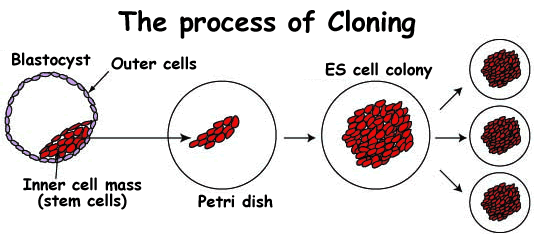Cloning requires the reprogramming of an adult or embryonic cell right back to the very start of development. Adult cells are more differentiated (specialised) than embryonic cells - they have made decisions about what sort of cell to be and these choices are said to be imprinted within the cell. For example, an embryonic cell has the potential to become all sorts of cell types, whereas an adult liver cell can only be a liver cell. So embryonic cells only have to "forget" a few decisions when they are cloned, whereas an adult cell has been through many more choices so, essentially, the clock has to be wound back further.
Cells remember what type they are due to epigenetic modifications of their DNA: molecular tags which mark certain genes as being switched on or off. These tags are very similar to those on the sperm which are removed shortly after fertilisation by reprogramming factors in the egg. In order for an adult or embryonic cell to be reprogrammed by cloning (by exposing it to the reprogramming environment of the egg), the epigenetic marks within the DNA must be removed. Adult cells are believed to have more of these tags than embryonic cells, so are harder for the egg to reprogramme.
Whether the donor cell is adult or embryonic, a successful clone must negotiate all the stages of development from one cell to a blastocyst and then on to being a fully-grown baby. But embryos can only be grown outside the womb in a test-tube until the blastocyst stage. After this, the embryo needs to form a placenta and take resources from the mother. Researchers must transfer the little balls of cells into the womb of an appropriate surrogate mother, where it can grow further. In fact, embryos created by mixing eggs and sperm in IVF clinics are usually transferred before the blastocyst stage- often when they only consist of two to eight cells.
Experiments in animals such have mice have shown that there is a high proportion of success in growing cloned embryos up to the blastocyst stage. Even embryos containing twice the normal number of chromosomes can grow quite happily to this point, even though a baby with this many chromosomes could never be born. Yet if these embryos are transferred into surrogate mothers, very few of them produce babies. This is because the egg contains many of the ingredients required for the early stages of development, and will direct the formation of a blastocyst even if there are severe problems with the DNA and chromosomes within the embryo. But to grow from a blastocyst to a baby requires complex patterns of genes being switched on and off. This can only happen if the DNA of the donor nucleus has been fully and correctly reprogrammed by the egg during the first stages of the cloning procedure. So it appears that even if you can create a clone, and even if that clone makes a blastocyst, you are still highly unlikely to end up with a baby.
But all is not lost. Blastocysts are extremely useful even if they don't go on to make a fetus. They are the source of the infamous embryonic stem cells, or ES cells for short. ES cells are made by removing the inner cell mass from the blastocyst and growing it in a dish (figure 2). After a time, a colony of special cells with almost magical properties appears. These cells have the capacity to form any tissue of the body, and can be treated with various chemicals to achieve this. They can also replicate themselves many times, to create large populations of useful cells. Genetic engineering techniques work very well in ES cells, allowing mutant genes to be repaired, and new genes to be added.


No comments:
Post a Comment